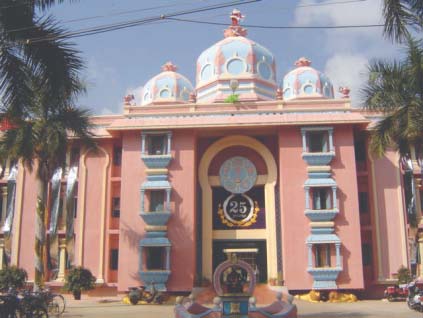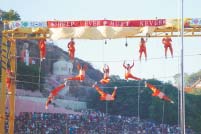Chapter 5
Table of contents return to Front page
Historical Development
Mission of the University
Distinctive Features of the University
Chancellor as the Motivator
Integral Education
Awareness Programme
Character: The End of Integral Education
Special Attention to Women's Education
Crest Jewel of University Education
References
Sri Sathya Sai University (formerly known as Sri Sathya Sai Institute of Higher Learning), with its Headquarters in Prasanthi Nilayam (Andhra Pradesh) in India, is the "crest jewel" of Sathya Sai Education. It is a visible manifestation of Sri Sathya Sai Baba's vision of education for the transformation of humanity. The Institute was recognised as a Deemed University by the Government of India in 1981. There are three campuses: the Prasanthi Nilayam campus for men at the University Headquarters, offering undergraduate and postgraduate courses with research facilities for doctoral candidates; the Anantapur campus for women, offering both undergraduate and postgraduate programmes; and the Brindavan campus for men, located at Whitefield near Bangalore, offering undergraduate courses.
The University is a non-profit, autonomous institution. The admission policy is open, based on an entry examination and admission is granted purely on merit. No consideration is given to caste, creed, income, region, religion, or language. Students come from different states in India, and a few from other countries, creating a national and international character for the University.
The medium of instruction is English.The University charges no tuition or entry fees for any of the courses offered. Besides, the University offers free medical treatment to all staff and students and provides scholarships to deserving students to meet hostel expenses.
High academic standards at the University are ensured by dedicated teachers who live on the campus. Students are provided the best opportunities and environment in and outside the classroom for achieving academic excellence. Research programmes in the University are designed keeping in view their relevance to social needs. The education at the University focuses on providing a higher order of reasoning and exploration. The University was the first in India to offer a five-year integrated course leading up to Master's degree, exposing students to rigorous thinking from the very first year. Reforms in syllabi are frequent and help to keep the academic programmes vigorous and dynamic. Evaluations of students' learning are conducted on an ongoing basis as also at the end of the semester.
—Sri Sathya Sai Baba
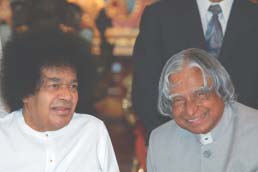
Sri Sathya Sai Baba with the President of India after the inauguration of the Sports Centre
Historical DevelopmentIn June 1966, Sri Sathya Sai Baba was at Anantapur, a town in Andhra Pradesh, 60 miles from Prasanthi Nilayam, at the invitation of a high school for girls.The plight of the girls who had to go to distant places for higher education, and also the kind of education for which they were spending much time and money, affected Sri Sathya Sai Baba. He resolved upon another step in his task of fostering righteous living for women. He announced that there would be a women's college in Anantapur soon. The Women's College was inaugurated on July 22, 1968. Sri Sathya Sai Arts and Science College for men at Brindavan, Whitefield, was inaugurated on June 9, 1969. Some years later on November 28, 1978 Sri Sathya Sai Baba laid the foundation stone of the College of Arts, Science and Commerce at Prasanthi Nilayam. Sri Sathya Sai Baba founded the Sri Sathya Sai Institute of Higher Learning on November 22, 1981 and has been guiding its course as the Chancellor from its very inception.The Institute began its operation with two campuses at Prasanthi Nilayam and Anantapur. A year later, the campus at Brindavan,Whitefield, became part of the Institute The latest addition to the constellation of colleges of the Institute, the Sri Sathya Sai Mirpuri College of Music in Prasanthi Nilayam, was inaugurated on November 20, 2000. The Institute (a deemed university) became Sri Sathya Sai University in February 2007. Mission of the UniversityThe Chancellor has declared the Mission of the University in the following words: "This institute has not been established just to prepare you for earning degrees. The main purpose is to help you cultivate Self-knowledge and Self-confidence, so that each one of you can learn Self-sacrifice and earn Self-realisation. "Teaching you the university curricula, preparing you for the university examinations, and awarding you university degrees — these are only means employed for the end, namely spiritual uplift, Self-discovery and social service through love and detachment. "Our hope is that by your lives, you will be shining examples of spiritual awareness and its beneficial consequences to the individual and society." Over the past twenty-five years the University is fulfilling this educational mission of Sri Sathya Sai Baba by "providing the youth with an education, which while cultivating their intelligence, also purifies their impulses and emotions and equips them with the physical and mental disciplines needed for drawing upon the springs of calmness and joy that lie in their own hearts." |
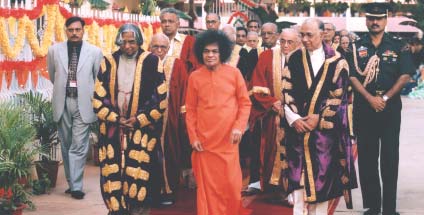
Sri Sathya Sai Baba on Convocation Day with the Chief Guest, the President of India
|
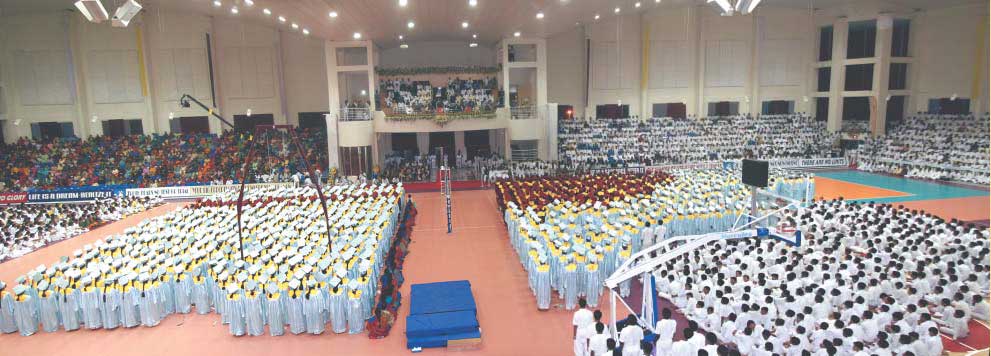
A panoramic view of the Twenty-fifth Convocation Ceremony of the Institute held at the Sri Sathya Sai International Sports Centre, 22 November 2006
Distinctive Features of the UniversitySri Sathya Sai University is a unique educational institution, which is redefining tertiary education in India and elsewhere in many ways. The University is widely recognised today by eminent educationists and educational authorities as a standard bearer of integral education, character building of the youth, and academic excellence combined with sports, fine arts, and social service. What are the distinctive features that make this University stand apart from other educational institutions in the world? The spiritual ambience of peace and character that pervades the environment of the University strikes a newcomer first. Other distinctive features noted by visiting dignitaries include: completely free education; the implicit discipline; emphasis on education in human values; a successful synthesis of spirituality with modern science and technology; the integrated five-year course; the mandatory awareness programme; commendable teacher-pupil ratio; excellent infrastructure including a Space Theatre (Planetarium) and an International Sports Centre conforming to Olympic standards. But the most distinctive feature of this University which makes it so unique is the triangular, mutually reinforcing, learning and transformation process that the University offers to every student: Lessons learnt in the immediate proximity and through direct interaction with the revered Chancellor; integrating values with secular knowledge through curriculum and classroom teaching; and translating these lessons into practical skills through daily living in the residential environment of the hostel, sports field, and social service. This is elaborated in the following sections. |

Brindavan Campus Anantapur Campus
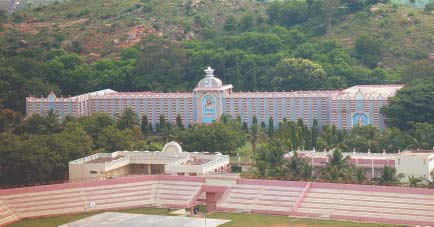
Prasanthi Nilayan campus with the Hill View Stadium in the foreground |
Chancellor as the MotivatorLife in the University revolves round its revered Chancellor, Sri Sathya Sai Baba. Right from the time a student enters the portals of the University, a sacred and unique relationship is developed with Sri Sathya Sai Baba which gives constant motivation to excel in every sphere of secular and spiritual activities. The students enjoy a unique privilege of being personally directed by him in matters relating to their academic, co-curricular, spiritual, and personal affairs. The strong personal bond that develops between the Chancellor and the students, his continuous loving guidance, the nurturing of values and the opportunity given to students to see those values in action through his daily life, lead to a remarkable transformation in the attitudes and behaviour patterns of students, and eventually in their perspectives toward life. |
|
Character: The End of Integral EducationThe outcome of integral education is best reflected in the positive character development that takes place in the students within a remarkably short period of time after they enter the Unversity.The University maintains a fully residential system and community living in dormitory-type hostels plays an important role in imbibing habits of sharing and caring, and the qualities of patience and perseverance among students from very early days. The warden of the campus and many teachers, some of them alumni of the University, live with the students under the same roof. They act as role models for the younger students and participate in many activities that are designed to develop an integrated personality of the students. Physical education is greatly encouraged, and each campus is well equipped with playgrounds, gymnasium, and training facilities. The emphasis in all these activities is to develop a "healthy mind in a healthy body", imbibing a sense of cooperation rather than competition. The sports ground serves as an arena for developing courage, confidence, and togetherness. This is best demonstrated at the annual Sports Day meet when boys and girls of the University perform most intricate aerobic feats high up in the air or perform acts of daredevilry with motorcycles after minimal practice, given their extremely busy schedule every day. The key to their Self-confidence lies in their love for the revered Chancellor and their determination to succeed to make him happy. The campus life also provides ample opportunity to nurture the talents of students in music, dance, drama, and public speaking. A strong social conscience is also fostered in the students who are expected to share some responsibility for service in the campus and in local villages. Evaluation by the University is not merely in academic learning but also in social service activities, sports and cultural events, elocution, and discipline. The teachers at the University regard themselves as co-learners and are exemplars of unity in thought, word, and action. There is no room for cynicism. |
If you ask me what is my property, many expect the answer to be - Oh! All these buildings, all this vast area of land. But my answer is: My entire property consists of my students. I have offered myself to them.—Sri Sathya Sai Baba
Self-confidence is the Foundation, Self-sacrifice is the Wall, Self-satisfaction is the roof and Self-realisation is life. This is the Mansion of life that one must aspire for.—Sri Sathya Sai Baba
|
Special Attention to Women's EducationWomen have always been at the forefront in all programmes of Sri Sathya Sai Baba. He established colleges for women in Andhra Pradesh, Madhya Pradesh, and Rajasthan, much earlier than he started colleges for men. He sees education as extremely important for young women who will be mothers and teachers of future generations. So he wants to prepare them to be better equipped to teach and guide their children wisely in accordance with noble precepts and practices. It is worthy of note that the former students of Anantapur College for Women have organised themselves as messengers of Sri Sathya Sai Baba and are doing commendable social service in several countries. They also meet annually at Prasanthi Nilayam. 'Crest Jewel' of University EducationA Peer Team of the National Assessment and Accreditation Council established by the University Grants Commission of India visited the University in 2002. Referring to the integral higher education provided by the University, the Peer Team said: "This made us realise that there is a way to correct our already degrading university education system in India, if we decide to do so." Based on the recommendation of the Peer Team, the National Assessment and Accreditation Council accredited the University at the highest level (A++) among the Indian universities. The Peer Team felt that "This Institute stands out as a crest jewel among the university education system in the country and this model is worthy of emulation by the institutes of higher learning in the country and elsewhere, so that these benefits would be reaped fast and on the widest possible scale." The University maintains a comprehensive website providing information to the public about course offerings, student life, campuses, research, admissions, annual events, calendar and other items of interest. http://www.sssihl.edu.in/ |
| |||
|
| ||||
ReferencesChakravarthi, K., (2006), Secular and Sacred Education in: Vidyagiri, Divine Vision, Book of Homage, Ed. Gokak, A.V., Sri Sathya Sai Institute of Higher Learning, Prasanthi Nilayam, Andhra Pradesh, India. Giri, S.V., (1999), Sri Sathya Sai Institute of Higher Learning - An Instrument in Bhagavan’s Mission, Sanathana Sarathi, Special Issue, November 1999, Sri Sathya Sai Books and Publications Trust, Puttaparthi, Andhra Pradesh, India. Gokak, A.V. (Ed.), (2006), Vidyagiri, Divine Vision, Book of Homage, Sri Sathya Sai Institute of Higher Learning, Prasanthi Nilayam, Andhra Pradesh, India. National Institute of Educational Planning and Adminstration, (2000), Best Practices in Higher Education: Integral Education: A Mission to Integrate Values in Education, National Institute of Educational Planning and Administration, New Delhi, India. Sri Sathya Sai Institute of Higher Learning, (2000), Sri Sathya Sai System of Integral Education, Sri Sathya Sai Institute of Higher Learning, Andhra Pradesh, India. |
||||
Sri Sathya Sai International Sports Centre, Prasanthi Nilayam |
||||
